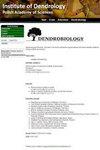钙肥对柏树无性系幼苗生长、根系发育及养分利用效率的影响
IF 1.8
4区 农林科学
Q2 FORESTRY
引用次数: 4
摘要
背景:柏树(Cupressus funebris Endl.)是我国亚热带的一个重要树种,也是在贫瘠场地条件下造林和恢复林地的主要树种。柏树被认为是一种含钙树,土壤中的可交换钙(Ca2+)能显著促进其生长发育。然而,大多数亚热带地区都有贫瘠的酸性土壤,其中Ca2+逐渐成为柏树生长的限制元素。结果:本研究在肥沃和贫瘠的土壤条件下添加不同浓度的Ca2+肥料。不同土壤条件下,柏树无性系对Ca2+的反应不同。在贫瘠的土壤中,添加3 g•kg− 1 Ca2+促进和延长苗高生长的速生期,增加株高和干生物量,促进细根发育 ≤ 直径为1.5mm,并且提高了柏树无性系中根系对氮(N)、磷(P)和钙的积累效率;然而,添加6 g•kg− 1 Ca2+对柏木株高生长和根系发育有抑制作用。在肥沃的土壤中,Ca2+的添加延缓和缩短了柏树高生长的速生期,但不同处理的株高和干生物量差异不显著;Ca2+的添加也抑制了细根的发育。高度生长快的无性系具有较大比例的直径根 ≤ 1.5 mm,N积累效率较高,而Ca积累效率仅在肥沃土壤中表现出基因型差异。结论:可在贫瘠的土壤中添加适量的Ca2+促进柏树幼苗生长,并可选择高生长快、细根发达的无性系在不施用Ca2+的肥沃土壤中进行培育和推广。本文章由计算机程序翻译,如有差异,请以英文原文为准。
Seedling growth, root development and nutrient use efficiency of Cypress clones in response to calcium fertilizer
Background:
Cypress (Cupressus funebris Endl.) is an important tree species in the subtropics of China, it is also a major tree species for afforestation and forest land restoration under infertile site conditions. Cypress is considered to be a calcicolous tree, whose there are growth and development can be promoted significantly by exchangeable Calcium (Ca2+) in the soil. However, most of the subtropical regions have infertile acidic soils, in which Ca2+ gradually becomes a limiting element for cypress growth.
Results:
In this study, different concentrations of Ca2+ fertilizer were added under fertile and infertile soil conditions. Cypress clones responded differently to Ca2+ addition in different soil conditions. In the infertile soil, the addition of 3 g•kg− 1 Ca2+ advanced and prolonged the fast-growing period of seedling height growth, increased plant height and dry biomass, promoted the development of fine roots ≤ 1.5 mm in diameter, and improved accumulation efficiencies of nitrogen (N), phosphorous (P) and Ca by the roots in cypress clones; however, the addition of 6 g•kg− 1 Ca2+ inhibited height growth and root development of cypress. In the fertile soil, Ca2+ addition delayed and shortened the fast-growing period for cypress height growth, but plant height and dry biomass did not differ significantly between treatments; Ca2+ addition also inhibited the development of fine roots. The clone with fast height growth had a larger proportion of roots with a diameter ≤ 1.5 mm and achieved higher N accumulation efficiency, while Ca accumulation efficiency showed genotypic differences only in the fertile soil.
Conclusions:
An appropriate level of Ca2+ can be added to infertile soil to promote cypress seedling growth, and clones with fast height growth and developed fine roots can be selected for cultivation and promotion in the fertile soil without Ca2+ application.
求助全文
通过发布文献求助,成功后即可免费获取论文全文。
去求助
来源期刊

Dendrobiology
农林科学-林学
CiteScore
2.20
自引率
11.10%
发文量
17
审稿时长
>12 weeks
期刊介绍:
Dendrobiology publishes original research articles and review articles related to the biology of trees and shrubs.
 求助内容:
求助内容: 应助结果提醒方式:
应助结果提醒方式:


